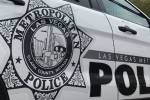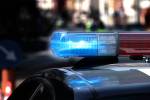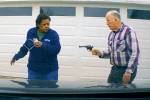Fire witnesses advised to stay out and report, as residential and wilderness blazes grow quickly
Las Vegas sees roughly 2,500 fires break out every year, said Tim Szymanski, public education and information officer with Las Vegas Fire & Rescue. He should know: In January 2013, his own house caught fire. The suspected cause? An exhaust fan in an upper-floor bathroom. The fire spread to the attic and resulted in about $50,000 worth of damage.
He was not home, and his pets escaped via pet doors. His neighbors spotted the smoke and called it in.
How to handle a building fire
If one is driving down a street and sees fire or smoke, what should they do? Calling 911 is the first priority. Officials say not to worry if you’re telling operators something they already know or if this is a false report. It’s better to be safe than sorry.
“It’s better to have a false alarm,” said Michele Steinberg, division manager for Wildland Fire Operations with the National Fire Protection Association. “My personal story: When I was a young child, somebody was doing laundry, and there was steam coming out of the dryer vent. Someone called 911 thinking it was smoke. It was a little scary but … we were grateful that someone bothered to notice and reported it.”
If no one is around, stopping and ringing the doorbell or pounding on the door to alert any occupants is the next step. It’s possible the people inside do not realize their home is on fire. If there is no answer, alert the neighbors. They may know if the owner is an invalid, away on vacation or a day sleeper. Neighbors may also be able to tell firefighters the layout of the house and where bedrooms are.
Going into a burning building is never a good idea, Szymanski added.
“If people go into a burning building, they’re not going to come out,” he said. “At about 120 seconds after a fire starts, which is about two minutes, the conditions are going to be untenable. At the three-minute mark, it’ll be so hot that your shoes could melt to the floor. So, we don’t want people to go in.”
People who have escaped as soon as the smoke alarm sounded have remarked that they could barely see to get out as the smoke was so thick and the fire spread so quickly, he said. But it’s not just smoke and flames that are of concern.
“In three to seven minutes, the temperature will be in excess of 1,000 degrees in there,” Szymanski said. “Your skin will melt at 160 degrees. If you breathe in air that’s 150 degrees or higher, you’ll burn the inside of your trachea and your lungs. That can all happen in less than three minutes. … We tell everyone to focus on escaping and not even call 911 until they’re outside and somewhere safe.”
Many house fires in nicer weather are due to barbecue grills. The Clark County Fire Department had these suggestions: Grills are to be used outside and away from siding and deck rails; keep a 3-foot safe zone around the grill — no pets or kids; clean the grill after each use, as grease residue can start a fire; and once cool, place coals in a metal garbage can and use the lid.
Of the 2,500 fires in Las Vegas each year, about 900 involve buildings, with 100 involving occupied buildings.
“If someone sees smoke coming out of the vents, it’s probably due to the air-conditioning unit,” Szymanski said. “We see a lot of those this time of year. The motor overheated or the belt burned up. It’s treated as though the whole house is burning. … The ones where the fire really gets out of control and results in considerable damage is about 100 a year, and that’s not vacant homes but the ones where people are going to need to be (relocated).”
Steinberg suggested having a plan in place — specifically, a meeting place for family members. She said parents can visit sparky.org with their children.
“The leading cause of home fires now is unattended cooking. It’s a mundane thing, but it’s easy to get distracted. It’s easy to have clutter,” Steinberg said. “But if you’re not able to control that within a few seconds, that’s when you need to leave and call 911.”
Outside the city
There are fire hazard warning signs as one is on the way to Mount Charleston — extreme, high, medium or low. The severity is determined by weather predictions and fuel conditions pumped into formulas. A computer program gives an analysis of that data.
Carrie Thaler, fire management officer for the combined Bureau of Land Management and U.S. Forest Service office gave an extreme example: “If Mount Charleston is covered in snow, then in that instance, the fire danger would be rated low. It (the sign) gives the public an idea of the chances of a big fire. Even if something is low, there are other things that can drive or push a fire, such as the wind. The wind is a very big component here.”
If you’re out in nature and see a fire, call 911. Seeing smoke is different than seeing flames, so that distinction should be relayed when you call.
How should people relay the location if they have no GPS?
Thaler said a description of the road or, even better, mile markers are helpful.
“Any type of landmark,” she said. “If they see smoke in the distance, any landmark or anything that can get us in the general area … we will have resources on the way.”
She said people should leave their name and a phone number with the 911 operator should the fire service need to get back to them.
“I wanted to emphasize that the person who sees the fire, their safety is the No. 1 priority,” said Naaman Horn, assistant public affairs officer with the Forest Service. “They don’t need to be tracking down information for us that is not readily available. The fire service and a bunch of different partner agencies have great expertise in figuring out what’s going on with the fire and how best to deal with it.”
Most fires in the wilderness are due to lightning strikes, but sometimes it’s not Mother Nature who’s at fault. The goal is not to have man-made fires start at all.
“Anyone can do little things, like not throw a cigarette out the window or not follow other regulations for being on public lands,” Horn said. “It’s important to know what you can and can’t do … and putting out your fires correctly. We ask people to be responsible while they’re out recreating. It can be pretty dry, and fires can start easily.”
To reach Summerlin Area View reporter Jan Hogan, email jhogan@viewnews.com or call 702-387-2949.





























